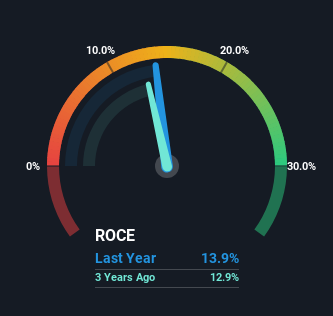- China
- /
- Construction
- /
- SHSE:605167
Jiangsu Libert (SHSE:605167) Will Be Hoping To Turn Its Returns On Capital Around

What are the early trends we should look for to identify a stock that could multiply in value over the long term? Firstly, we'll want to see a proven return on capital employed (ROCE) that is increasing, and secondly, an expanding base of capital employed. Put simply, these types of businesses are compounding machines, meaning they are continually reinvesting their earnings at ever-higher rates of return. Having said that, from a first glance at Jiangsu Libert (SHSE:605167) we aren't jumping out of our chairs at how returns are trending, but let's have a deeper look.
Return On Capital Employed (ROCE): What Is It?
Just to clarify if you're unsure, ROCE is a metric for evaluating how much pre-tax income (in percentage terms) a company earns on the capital invested in its business. To calculate this metric for Jiangsu Libert, this is the formula:
Return on Capital Employed = Earnings Before Interest and Tax (EBIT) ÷ (Total Assets - Current Liabilities)
0.14 = CN¥258m ÷ (CN¥3.0b - CN¥1.1b) (Based on the trailing twelve months to June 2024).
Therefore, Jiangsu Libert has an ROCE of 14%. On its own, that's a standard return, however it's much better than the 5.7% generated by the Construction industry.
See our latest analysis for Jiangsu Libert

In the above chart we have measured Jiangsu Libert's prior ROCE against its prior performance, but the future is arguably more important. If you'd like, you can check out the forecasts from the analysts covering Jiangsu Libert for free.
What The Trend Of ROCE Can Tell Us
On the surface, the trend of ROCE at Jiangsu Libert doesn't inspire confidence. Around five years ago the returns on capital were 18%, but since then they've fallen to 14%. Although, given both revenue and the amount of assets employed in the business have increased, it could suggest the company is investing in growth, and the extra capital has led to a short-term reduction in ROCE. If these investments prove successful, this can bode very well for long term stock performance.
On a related note, Jiangsu Libert has decreased its current liabilities to 38% of total assets. That could partly explain why the ROCE has dropped. What's more, this can reduce some aspects of risk to the business because now the company's suppliers or short-term creditors are funding less of its operations. Since the business is basically funding more of its operations with it's own money, you could argue this has made the business less efficient at generating ROCE.
In Conclusion...
While returns have fallen for Jiangsu Libert in recent times, we're encouraged to see that sales are growing and that the business is reinvesting in its operations. These trends are starting to be recognized by investors since the stock has delivered a 4.9% gain to shareholders who've held over the last three years. So this stock may still be an appealing investment opportunity, if other fundamentals prove to be sound.
While Jiangsu Libert doesn't shine too bright in this respect, it's still worth seeing if the company is trading at attractive prices. You can find that out with our FREE intrinsic value estimation for 605167 on our platform.
While Jiangsu Libert may not currently earn the highest returns, we've compiled a list of companies that currently earn more than 25% return on equity. Check out this free list here.
New: Manage All Your Stock Portfolios in One Place
We've created the ultimate portfolio companion for stock investors, and it's free.
• Connect an unlimited number of Portfolios and see your total in one currency
• Be alerted to new Warning Signs or Risks via email or mobile
• Track the Fair Value of your stocks
Have feedback on this article? Concerned about the content? Get in touch with us directly. Alternatively, email editorial-team (at) simplywallst.com.
This article by Simply Wall St is general in nature. We provide commentary based on historical data and analyst forecasts only using an unbiased methodology and our articles are not intended to be financial advice. It does not constitute a recommendation to buy or sell any stock, and does not take account of your objectives, or your financial situation. We aim to bring you long-term focused analysis driven by fundamental data. Note that our analysis may not factor in the latest price-sensitive company announcements or qualitative material. Simply Wall St has no position in any stocks mentioned.
About SHSE:605167
Jiangsu Libert
Designs, manufactures, and sells industrial modules in China and internationally.
Excellent balance sheet and good value.
Market Insights
Community Narratives



